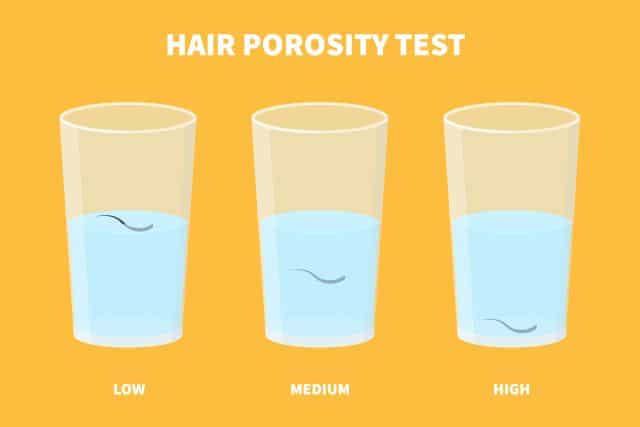Last Updated on December 30, 2022 by Gaga
What is Hair Porosity?
Hair porosity is the term used to describe the hair’s ability to absorb moisture, nourishing products, or chemical treatments. There are three degrees of hair porosity: high, medium (normal), and low.
Overly porous hair has damaged cuticles that have lost their tightness due to excessive usage of thermal appliances or frequent chemical processing. Highly porous hair can absorb excessive amounts of water but is not able to retain its internal moisture.
Low porosity hair, also called resistant hair, refers to cuticle scales that are tightly sealed, not allowing moisture or chemicals to easily enter or leave the hair shaft. Low porosity hair generally looks healthy and has lots of sheen because of the smooth cuticle layer. Another advantage of having low-porosity hair is that color doesn’t tend to fade quickly.
Hair that has medium porosity falls in the middle of the spectrum and is considered ideal as it responds well to styling products and chemical treatments. The cuticle of normal porosity hair is flexible, allowing the right amount of moisture to pass into the cortex.

If you find it hard to saturate your hair with water in the shower, that may be a good indication of its low porosity level. A simple strand float test can be performed to determine your hair porosity, but the hair products you use can lead to inconsistent results. It is best to do the strand float test after using a clarifying shampoo when your hair is freshly clean.
It is advisable to have your hair examined by a professional to get more reliable results. Knowing your hair’s porosity level, you can adjust your hair care regimen and select products that are compatible with the condition of your hair.
Why is Lower Porosity Hair So Frustrating?
Although considered healthier than high porous hair, low porosity hair is not ideal when it comes to the absorption of moisture and responsiveness to hair treatments. When deprived of moisture, hair strands can become inelastic and fragile.
If your low-porosity hair becomes dehydrated for some reason, you need to put in additional effort to infuse your strands with moisture.
Low-porosity hair is more susceptible to product build-up, because hair products don’t pass the cuticle layer, but rather sit on the hair shaft making your locks feel greasy.
Hair with low porosity is more resistant to chemical processing, such as perming or coloring than hair with normal or high porosity. If you are dealing with resistant hair, keep in mind that it will take longer for chemicals to penetrate the cuticle to work.

This post contains links to Amazon. The publisher may get paid if You purchase something through the links without additional costs to You.
Low Porosity Hair Regimen
Lower porosity hair requires a different approach than the hair of medium or high porosity. You need to learn some tips on how to get hair treatments absorbed into the hair shaft and how to keep your strands healthy and beautiful.
Deep conditioning treatments: Deep conditioning, at least once a month, is crucial for infusing low-porosity hair with necessary moisture. To get the most benefit, apply the product to clean, damp hair. Also, apply mild heat to make the treatment more effective.
The best way to help moisture enter the hair shaft is to incorporate a steamer or a heated gel cap into your hair care regimen. Using a hair steamer for 15-30 minutes helps loosen up tightly closed cuticles, allowing the conditioning ingredients to penetrate the hair shaft and infuse your strands with moisturizing nutrients. If you don’t have either of those tools, sit under a hooded dryer with a plastic cap on for 10-15 minutes. Wait for about two hours if you are using a plastic cap and your body heat.
Deep conditioner for low porosity hair: Jessicurl Deep Conditioning Treatment is an intense protein-free and silicone-free deep conditioner that infuses dry and curly hair types with much-needed moisture. This thick and creamy conditioner uses cocoa butter and shea butter to hydrate dry hair, leaving it soft, shiny, and easy to detangle. It has either citrus lavender or island fantasy scent while for fragrance-sensitive people an unscented option is available.
Clarifying: Buildup can prevent hair from absorbing water when a moisturizing treatment is applied. Use a clarifying shampoo once or twice a month to remove old, lingering products from your strands. Follow with a protein-free rinse-out conditioner.
Bentonite clay is a great natural deep cleanser for low-porosity hair. It has strong absorptive properties that attract impurities and remove excess product buildup. A bentonite clay hair mask softens resistant hair, making it more manageable and receptive to styling products.
Wash your low-porosity hair with warm instead of cold water to help the cuticle open a bit, allowing moisturizing ingredients from the conditioner to enter the hair shaft. After conditioning, rinse with cool water to close the cuticle and seal the moisture inside the hair.
Use a water-based, leave-in conditioner on damp hair after every shampooing. Liquid-based leave-in conditioner, which contains little to no protein, will infuse your non-porous hair with hydration and lubricate the hair shaft, without coating the hair with too much product.
To meet the requirements for low-porosity natural hair, Shea Moisture has created a new, porosity-based product line. Shea Moisture Low Porosity Hair-Line includes Low Porosity, Protein-Free Shampoo, Tea Tree Oil Low Porosity Protein Free Conditioner, and Leave-In Detangler.
Another brand that caters to the needs of low-porosity hair is TGIN (Thanks Good It Is Natural).
Rose Water Smoothing Leave-In Conditioner for Natural Hair is a light, protein-free leave-in conditioner that leaves thirsty low porosity hair soft and moisturized.
Also, consider Rose Water Sulfate-Free Hydrating Shampoo.

What Products Should You Avoid?
There are some products that your non-porous hair won’t like:
Silicones: Avoid using products containing water-insoluble silicones because you already have a compact hair cuticle layer and don’t need anything that can coat the hair shaft. Water-soluble silicones are easily washable with a mild shampoo. To remove the residues of water-insoluble silicones, you need to use sulfate-containing or clarifying shampoo.
Protein-rich conditioners: Avoid heavy and creamy, thick conditioners that can weigh down your hair. Use a lightweight or diluted rinse-out conditioner to provide good slip for smooth detangling.
Protein-enriched styling products: Protein-rich leave-in products may not be beneficial for low porous strands because there are not many tears or gaps in the cuticle layer that need to be filled. Protein particles that bind to the hair can block already tightly closed cuticles preventing the absorption of moisture and products.
Heavy oils: Avoid using heavy hair oils for styling purposes, as these can’t be absorbed and will sit on the hair’s surface. Use hair oils in small quantities, preferably lightweight moisturizing formulas such as jojoba, argan, baobab, and sweet almond oils. These oils can easily penetrate the hair shaft. However, heavier oils work well for hot oil treatments because they can be absorbed when warmed up.
Co-washing: Washing your hair with a cleansing conditioner will lead to build-up over time. If you stick with the co-washing method, you need to regularly cleanse your non-porous hair with a clarifying shampoo.

How to Apply Chemical Treatments to Hair with Low Porosity?
A disadvantage of lower porosity hair is that the compact cuticle layer doesn’t allow chemical treatments to enter the hair shaft. Chemical services such as coloring or permanent waving can be difficult to perform or processing time may take longer than normal. A clarifying treatment before processing will make the hair more receptive to the perm service.
Low porosity hair absorbs color at a slower rate than high porous hair because the hair shaft repels chemicals. Since such hair resists chemical services, color absorption may take longer than stated on the box.
Make sure to apply hair dye to perfectly clean hair because dirty hair is more resistant to chemicals than clean hair. Crystal Clarifying Treatment by Ion is designed to remove hard water and product build-up to prepare hair for chemical services.
Dying low-porosity hair may slightly increase the porosity level and make hair less resistant to penetration of hair products.

Gaga is a blogger and founder of the Softer Hair website. She often says that insomnia is to blame for her first blogging attempts. Being the night owl, she hated the morning alarm. She left her office job and returned to what she loved most - writing.


I’m confused about closing the pores with cold water after conditioners. If you close the cuticles at that point, how are the moisturizer and oil suppose to penetrate each strand?
Oils that have the ability to penetrate hair such as coconut and avocado oils work best as a pre-shampoo treatment or when added to your deep conditioning treatment. The heat helps raise the cuticles, speed up the penetration and enhance the conditioning effects of oils and other ingredients in deep conditioners.
When used as a styling product (after you have washed your hair and applied a cool rinse), hair oils or hair serums are not meant to open the cuticle and enter hair shaft to work. These products work by coating hair shaft to increase moisture retention, shine, and softness.
I would suggest applying a finishing rinse with cool or lukewarm water, but try not to expose the entire head to cold water, because that is not good for your sinuses.
If oils such as coconut and avocado can penetrate the hair shaft wouldn’t it be better to use at the end of your regime? I would want clean hair first before having oil to penetrate my hair shaft? The Loc method I believe is best for me. Great information!
what is a suggested hair blow-drying temperature for after the cool rinse since the cool rinse closed the cuticles? I normally use high/hot temperatures to dry my hair which leaves my hair looking and feeling back to dry and stiff as ever. any suggestions? thanks in advance!
live in Orlando need an excellent steam ing cap where to get one